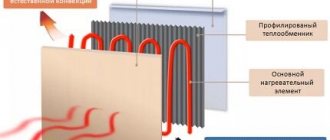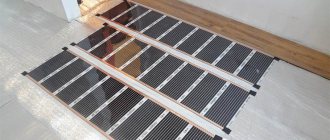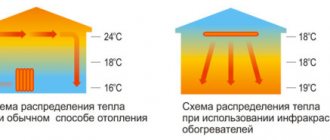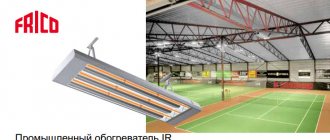IR heaters today are stylish, fashionable, practical and efficient. This type of climate control equipment is extremely economical in terms of electricity consumption, and its design allows you to quickly start heating the room. In addition, the IR heater does not dry out the air.
The versatility of using this type of heater is another advantage that can be realized when installing it in any room. Today, IR heaters can be found in any form, which allows you to expand the choice for a potential buyer.
In this article we will tell and show IR panel heaters and which ones are best to choose.
TOP 7 IR heaters
Information on infrared heating
Infrared thermal panels are direct heaters. The technology is based on the use of light waves from the region below the visible region of red light (long infrared waves IR-C*). This heat can be compared to the sun's rays. Infrared radiation is completely natural and safe. Moreover, it works well for consumers (used in maternity hospitals for many years). The most visible source of infrared heat wave is, of course, the Sun. Using room heating based on infrared heating panels, you bring a small solar home! The waves emitted by the panels reach the body without heating the air, creating a feeling of soothing warmth and comfort.
Infrared radiation waves are divided into three types: short wavelengths near visible light IR-A (>700°C), medium wavelengths IR-B (about 250–700°C) and long wavelengths IR-C (<250°C). A person is able to sense infrared heat waves when the temperature of a given object is above 22°C, but, of course, the higher the surface temperature, the greater the susceptibility of the heat wave.
Advantages and disadvantages of a solar heating system
There are not many advantages of a solar heating system, but each of them becomes a reason for constant experimentation:
- environmental Safety. This is an environmentally friendly source that is safe for residents and the environment and does not require the use of standard types of fuel;
- autonomous work. The owners of such systems do not depend on the cost of energy resources and the economic situation in the country;
- economical consumption. By maintaining a standard heating system, you can reduce the cost of paying for hot water supply;
- availability. To install solar panels for heating your home, you don’t need to go to authorities and ask for permission.
Users also highlight disadvantages:
- high cost of juice equipment, which is necessary to put the system into operation;
- direct dependence of the volume of heat received on geographic location and weather;
- the presence of an additional source (solar system or gas boiler).
To get greater returns, you need to constantly monitor the serviceability of the collectors, clean them of debris and protect them from the formation of ice at low temperatures
If the temperature is often below 0 degrees, then it is important to take care of additional thermal insulation not only of the solar system parts, but also of the house
Heat waves emitted by infrared panels
In the case of traditional heating, according to the principle of air circulation in the room, the heat increases. Therefore, the space under the ceiling heats up more than on the floor. In the case of infrared heating, walls, objects and people heated by the thermal infrared panels generated by the heat release the accumulated heat, thereby achieving thermal comfort throughout the room with an even temperature distribution.
Unlike traditional heating systems, infrared thermal panels do more than simply heat the air in a room. The infrared waves emitted by our devices generate heat when they come into contact with the surface of a wall, object or body. After contact with infrared waves, heat is absorbed by an object and then slowly released into the environment while being reflected to other objects, which also absorb it. As a result, users can be said to be dealing with two types of heat:
- Direct (radiation) – emitted by panels;
- Indirect (radiation) – emitted by surfaces and objects.
This enhances the effect of uniform temperature distribution in the rooms. Thanks to this, we get rid of the feeling of “cold feet” and “hot heads”. In turn, the heated walls remain dry over the entire surface. Thanks to this, you can further eliminate the moisture problem and prevent the development of mold and mildew. By drying the walls, improve their insulation properties (a dry wall is better insulated due to lower thermal conductivity than a wet wall), thereby reducing the need for heat.
Selection rules
Using such devices is a more efficient way to heat your own home. But you need to know how to choose the right equipment. First of all, you need to decide for what purpose the device will be used.
If you need a model that will be the main source of heating, then first of all you should pay attention to power. It is desirable that the device have at least 100 W/sq.m. If in a city apartment the ceiling height is more than 3.5 m, then you need to focus on the norm of 120-130 W/sq. m.
You should approach the choice of panels more carefully, based on your needs
There are other factors that may influence the selection of an infrared heating device:
- Walls in the room. Their type, as well as the presence of insulation structures on their surface.
- Glazing quality. It matters here what type of windows are installed in the openings, how effectively the sashes are pressed against the frame, and whether the products contain energy-saving glass.
- Ceiling characteristics. What is the condition of the ceiling, what is located on top - another apartment or a roof.
All these factors have a significant impact on heat loss in the room.
The advantage of infrared panels
In the case of heating with infrared thermal panels, noticeable thermal comfort is achieved at temperatures approximately 2–3°C lower (than in the case of convection heating). Thanks to this you can achieve cost savings of 10%, for example a room with a measured temperature of 18°C will feel around 20–21°C. We will feel a similar effect on a hot day under the rays of the sun - when we return to the shade, we immediately become colder, despite the same air temperature in the sun and in the shade. As the temperature decreases, the amount of heat transferred through the space decreases due to the smaller difference in temperature between inside and outside, thereby reducing heat loss during air exchange (through stomata, barrels).
Behind the above there is another advantage, that is, an increase in air humidity associated with a decrease in its temperature. In such conditions, the mucous membranes (the body's natural defense against colds) do not dry out, especially in winter. Not using traditional convection heat indoors prevents the growth of dust, pollen, bacteria and other particles, which is especially important for sensitive people or those with allergies. As you can see, a favorable microclimate is created in an infrared heated room.
The operation of infrared thermal panels can be compared to the operation of a good old tiled stove, which also transfers heat without the participation of air and therefore without emissions. The cozy warmth of such a stove consisted of two factors: the crisp, still and dusty air and the warm walls. A tile stove, usually located on the inside wall of a room, can radiate heat evenly to all walls. The intense heat radiation from the furnace heated the interior walls, leaving the air in the room cold.
Scientific research shows that people in a room with high air temperature and cool walls will feel cold, and in a low air temperature but with warm walls, they will be warm.
Savings associated with the use of infrared heating panels:
- Long service life of thermal panels, trouble-free and waste-free operation - eliminating the cost of replacing the heating system in just a few years;
- No system maintenance costs – heating panels do not require periodic maintenance and inspections such as a chimney or furnace;
- Energy efficiency - there is no heat loss, as when it is transported through pipes from the furnace to the radiators, and also high efficiency (more than 98% of electricity is converted into heat). Compared to traditional heating methods, we can count on cost savings of up to 30% during the heating season, and up to 60% during transition seasons!
- Relatively low purchase cost and ease of installation - there are no high costs for the purchase and installation of a convection system. An infrared heating system will typically be 30-50% cheaper;
- Saving space in the building - there is no need to allocate space for storing fuel or a room for the stove.
Features of infrared heating panels:
- Efficient (up to two times more efficient than other heating systems);
- Environmental friendliness (no energy loss, no emissions - they perfectly complement each other with solar panels);
- The device is easy to assemble (without high installation costs, taking into account the plumber or pipes);
- Universal fastening (the panels can be installed on the wall or ceiling, saving space);
- Adaptation of devices to the individual character of the interior or the purpose of the room (you can choose the color of the panels or place the selected pattern on them; options for panels with a glass surface or in the form of a mirror are also available);
- Almost instantaneous heating effect (the panels heat up quickly, within a few minutes);
- There are no system maintenance costs (no need for periodic maintenance and inspection of heating panels);
- High quality and durability of the devices, which is reflected in the 5-year warranty and compliance with CE certificates;
- Flexibility of using heating panels - can be used in one room, difficult to heat, or as a general heating system;
- Convenience and ease of use – the ability to use various thermostats (wired and wireless) and heat individual zones;
- Elimination of condensation (condensation), elimination of moisture and mold in the room;
- There is no convection (air movement) and drying of the room;
- Eco-friendly - ideal for people with allergies (no dust in the air), does not create noise or odor.
Selection of infrared heaters
The best results in energy savings will be obtained by using "excess power" because stronger panels reach the set temperature faster and turn off earlier, resulting in lower energy consumption (reduced operating time of heating devices). A properly selected infrared heat panel should not be turned on for more than 6 hours a day to maintain a favorable room temperature on frosty days. The costs of purchasing the panels are one-time, but the operating savings are achieved over many years.
Taking into account the economic aspect of heating using infrared thermal panels, the building's heating power requirement from the panels should be calculated according to the principle:
A).30-35 W / 1 m³ for the main heating system (30 W - the building is well insulated, 35 W - in the absence or insufficient insulation of the building),
B).12-15 W / 1 m³ for an autonomous heating system (when using an additional heating system).
Additional options
Ceramic panel with thermostat
Like most modern appliances, ceramic heaters have many improvements. The first and most important thing is a thermostat, which allows you to change the heating temperature manually or automatically.
Another important function is protection against voltage surges. It will protect the device from sudden power surges that occur both in apartments and country houses.
The fan control feature reduces power consumption. In cold weather, you can run the fan at maximum, and when it gets warmer, slow it down or stop it completely. By the way, some models have a blowing mode without heating, thanks to which the heating device turns into a device that provides coolness.
A filter is usually installed on the fan ducts to protect against dust. It is designed for a long service life without replacement. It only needs to be removed occasionally, washed and returned to its place.
The most modern heaters are equipped with air-cleaning and air-ionizing lamps. It is worth noting that the effectiveness of such devices is not indisputable, but many find them useful.
Application of infrared panels
Heated thermal panels work well in a wide range of applications. Examples:
- heating of apartments, houses, holiday homes, winter gardens;
- heating of offices, conference rooms;
- heating of shops, service points, trading areas;
- heating of halls, warehouses, workshops, loading ramps;
- heating of exhibition and exhibition halls;
- communal heating;
- heating schools, kindergartens,
- heating of museums and galleries;
- heating of catering establishments;
- heating of hotels, sanatoriums, shelters;
- heating of hospitals and sanatoriums;
- heating of churches and places of worship;
- heating of sports halls, entertainment halls, sports halls;
- heating in zoological and botanical gardens;
- heating in livestock and crop production;
- heating in saunas, swimming pools and fitness clubs and much more.
Conclusion
A heating system based on infrared thermal panels is the optimal solution for all types of health centers. This is the additional value that can be offered to the customer, lower installation and heating costs, better and healthier well-being. Long infrared waves help improve the circulatory system, strengthen the immune system, have a positive effect on rheumatoid arthritis, increase the stretch of collagen tissue, reduce joint stiffness and reduce muscle spasms.











